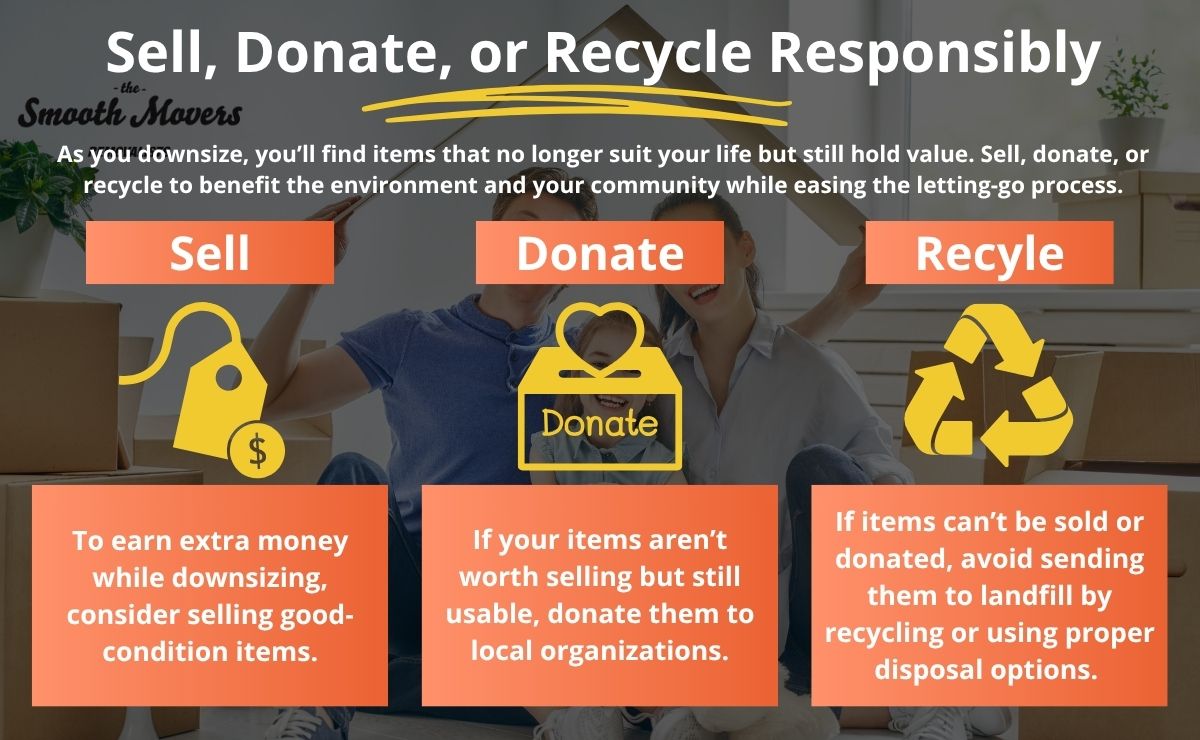
Regardless of whether you’re an empty nester, retiree, or simply want to live a simpler life, the idea of downsizing can be both exciting and terrifying. Downsizing your home is not only a practical decision; nowadays, it has become a purposeful way of life.
Downsizing is no longer a new phenomenon, as the cost of homes continues to rise, families are changing, and more individuals are embracing minimalism. Even the owners of big homes are opting to sell their space in exchange for freedom—financial, emotional, and physical. Less space, typically, requires less work to maintain, less money on utilities and more time to spend on other things (and people) that are important.
But knowing how to downsize—and where to start—can feel daunting, especially if you’re moving to a smaller house and decluttering a lifetime of belongings. That’s where this guide comes in.
Whatever stage you are at in downsizing your house, this guide will lead you through the process- step by step.
Understand Why You’re Downsizing
Before you start sorting or making plans for how to move your belongings, take a step back and ask yourself: Why am I downsizing? Knowing the reason that motivates you is one of the first steps in determining how to downsize your home effectively and purposefully.
Are you hoping to:
- Save money and simplify your budget?
- Reduce clutter and live more minimally?
- Relocate to be closer to family or healthcare?
- Transition to a more manageable property with less maintenance?
Having a clear intention will not only make the process smoother but also more rewarding. It can be especially helpful when facing the emotional challenge of moving to a smaller house and decluttering a lifetime of belongings. With your “why” in mind, decisions about what to keep, sell, or let go of become easier.
Beware, if you want to know how to downsize, begin by being truthful with yourself about what you need and desire in your next chapter. When you have decided why you are doing it, the remaining process of downsizing house, sorting, and settling in will be a lot more purposeful.

Evaluate Your New Space
Once you’ve decided to downsize, the next step is to get familiar with the space you’re moving into. Understanding its layout and limitations will shape every decision you make as you begin downsizing your home.
To begin, compare the square footage and floor plan of your existing house and the new one. Lost a guest room? Is the kitchen smaller? Fewer closets? It can also avoid overpacking, sparing you the experience of bringing furniture or items that simply won’t fit.
Remember, downsizing house doesn’t mean sacrificing comfort. It means being intentional about your space. And if you’re moving to a smaller house and decluttering a lifetime of belongings, knowing the function and flow of your new home will help ensure your new environment supports—not limits—your lifestyle.
The bottom line is that downsizing successfully requires an accurate picture of what you want to achieve right now, not what you’re leaving behind.
Take Inventory of What You Own
You need a clear visual idea of what you possess before you can begin downsizing your home. Inventory may sound like a chore, but it is one way to stay organised when downsizing.
The first step is to conduct a room-by-room assessment using a notebook, moving house checklist, or spreadsheet. It’s to help you divide the work into manageable parts so it doesn’t overwhelm you.
As you go, focus on identifying:
- Duplicates: Do you really need four mixing bowls or three sets of dishes?
- Underused items: When was the last time you operated that treadmill or ice cream maker?
- Sentimental vs. practical value: There is meaning in some things, but not all the things that you keep should accompany you to the next chapter.
When space is limited, every item must earn its place. A thoughtful inventory will highlight what truly adds value to your daily life—and what’s simply taking up space.
When shelves are scanty, every item must earn its place. Taking inventory makes it easier to plan what will physically fit in your new home. The more aware you are of what you own, the more empowered you’ll feel to let go of what no longer serves you.
Declutter Strategically
Downsizing your home can be a daunting task, especially when considering everything you own. Having a strategy is therefore necessary. Decluttering is not about throwing things away- it is about making thoughtful, even emotional choices. It also helps you with moving costs.
Start with a proven decluttering method that suits your style:
- The KonMari Method: Ask yourself if each item “sparks joy.”
- The 4-Box Method: Label boxes as Keep, Donate, Sell, Trash. Sort as you go.
- Minimalist Game: Declutter a fixed number of items each day (excellent momentum builder).
Begin with items that have no emotional attachment, such as linens, kitchenware, and decorative pieces. These tend to be less painful to let go of and will allow you to develop confidence before having to deal with sentimental items.
When downsizing a house as a couple or family, make it a family exercise. Get everyone involved in what should be considered part of the new home, and allow each person to have a space of their choice.
Here’s how to pack for a move.

Sell, Donate, or Recycle Responsibly
The more you downsize your home, the more you are bound to find things that are no longer useful to your way of life–yet are of value. Do not simply discard everything else; instead, sell, donate, or recycle intelligently. This is a great option if you don’t know what to do with unwanted furniture. Not only is this beneficial for the environment and your community, but it can also help ease the burden of letting go.
Sell What Still Has Value
In case you want to gain some extra money during the process of downsizing, selling off some of your items that are in good condition may interest you:
- Facebook Marketplace or local buy/sell groups: good for furniture, tools and household goods
- Garage sales: best suited to clear a house in a short time
- Consignment shops: clothing, designer pieces and antiques are best here
- Online platforms like eBay or Poshmark: helpful with speciality or collectables
Donate to Help Others
Many belongings still have life left in them, even if they’re not worth selling. Donate gently used items to local organisations such as:
- Goodwill, Habitat for Humanity, or Salvation Army
- Local shelters or community centres
- Libraries (for books and media)
- Schools or churches (for furniture, supplies, toys)
Before dropping off donations, check what each centre accepts. Not all places accept mattresses, electronic goods, or bulky furniture; it is time-consuming to get into and out of a place and realise the goods cannot be accepted. Being informed saves time.
Related: Where to Donate Books, Where to Donate Clothes, and Where to Donate Furniture in Perth
Recycle What You Can’t Rehome
Other goods cannot be sold or potentially donated- nevertheless, they should not be thrown out to the landfill. Spare some time to find:
- Electronics recycling centres for old TVs, computers, and cords
- Furniture recycling through local waste management or non-profits
- Hazardous waste disposal for paints, batteries, and cleaning products
Learning how to downsize your home responsibly means thinking beyond convenience and considering the long-term benefits. It’s about honouring what you own and making smart, sustainable choices.
Whether you’re early in the process of downsizing house or almost done, taking these extra steps can give your belongings new purpose—and make your move feel a little more meaningful.
Plan the Move Efficiently
When you are past some of the process of downsizing your home, now you need to turn to the actual logistics of the move. No matter whether you relocate across town or move interstate, a well-planned move will make your downsized move easier and less stressful.
Just a reminder: when you downsize house, you are carrying less. The less you relocate, the cheaper and more effective it will be. Avoid the temptation to make “just in case” packs, you have already selected what to pack through the decluttering process, so stay committed to them.
If you’re moving long distances, having a plan to move interstate or regionally is the first thing to do.
Consider Professional Help
When you are struggling with time or a lot of energy it is a great relief to hire professionals. These Perth removalists assist with all aspects of sorting, packing, logistics, and setting up the new space.
Label Everything Clearly
Label your packages, room by room and prioritise by level (e.g. Kitchen-High priority or Guest Room-Low priority). This can assist you and your movers in determining which boxes need to be opened first and which can wait.
Set Up the Essentials First
Once you relocate to your new house, the first thing is to make the kitchen, bedroom and bathroom operational. These functional spaces, which you use daily, will help you feel grounded as you transition through the process, even though the rest of the house may still be in boxes.
Find out some of the things you may need when moving.

Adjusting to Your New Lifestyle
The moment when the boxes were unloaded and furniture was put in its place, a new chapter truly opened. Moving is not the only reason for downsizing your home; it is about adopting a new lifestyle. You can now enjoy the lifestyle you created by downsizing.
With the freed-up time that comes with no longer maintaining a larger property, consider how you want to spend this time. This is in your hands to create a life that reflects your values.
Accept that things take time. No, it’s okay if it takes a few weeks — or even months — to get adjusted properly. Have patience in the process and take pride in your work.
Common Mistakes to Avoid
Downsizing your home will bring freedom, but there are many pitfalls to avoid. Being aware of some common mistakes can make a significant difference between a relaxing and a straining relocation process. If you’re learning how to downsize, keep these common missteps in mind as you navigate the process.
Rushing the Process
Downsizing takes time—emotionally and practically. Don’t try to declutter an entire house in a weekend. Especially if you’re moving to a smaller house and decluttering a lifetime of belongings, you need space to make thoughtful decisions. Give yourself enough lead time to sort, pack, and adjust at a comfortable pace.
Not Measuring the New Space
It’s easy to assume your favourite couch or dining set will fit in the new place—until moving day. One of the most common mistakes in downsizing a house is forgetting to measure doorways, room dimensions, or storage space. Always compare your current furniture to your future layout so you don’t bring items that overwhelm your new home.
Holding Onto “Just in Case” Items
Keeping things “just in case” is a slippery slope. Those backup kitchen appliances, extra linens, or unused electronics might feel like they could come in handy—but they add up quickly. A big part of learning how to downsize your home is trusting that you’ll have what you need, and letting go of what you don’t.
Forgetting to Update Key Information
Amid the chaos of a move, it’s easy to overlook admin tasks like:
- Changing your mailing address
- Transferring utilities
- Updating insurance, driver’s licenses, and voter registration
Make a checklist to ensure all your important accounts and services reflect your new address. It’s a small but crucial step to settle into your new life after downsizing fully.
Discover How The Smooth Movers Can Help You!
Maximising the space by downsizing your home is more than a move; it’s a transition and a reflective process. Regardless of your reason for downsizing your home, just know that this is a process aimed at making room in your life to focus on what is important.
Give yourself the time to celebrate how far you’ve come. From sorting through decades of belongings to reimagining life in a smaller space, you’ve made intentional choices that support your next chapter. That is worth a party.
And remember—you do not have to do it all on your own. If you find this a huge task or you need professional support to ensure a smooth move, The Smooth Movers are ready to assist. We can help you downsize with our moving services, including packing and relocating with care and efficiency, so that you can adapt to your new, simplified life.
Contact us today to receive a quote and discover how we can assist you with every step of your downsizing home journey.



